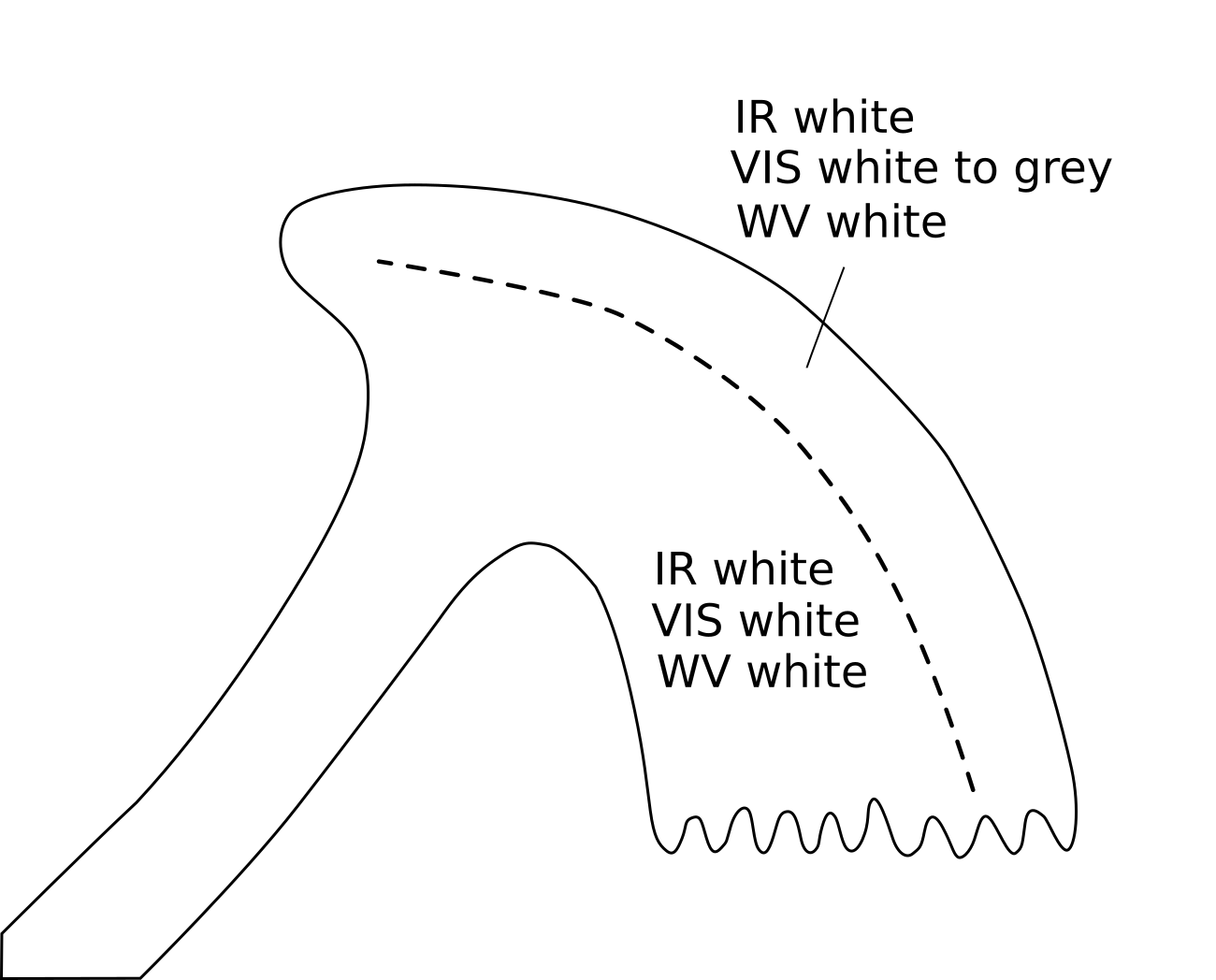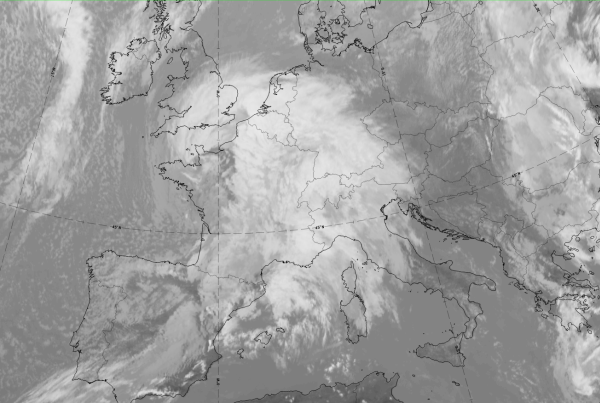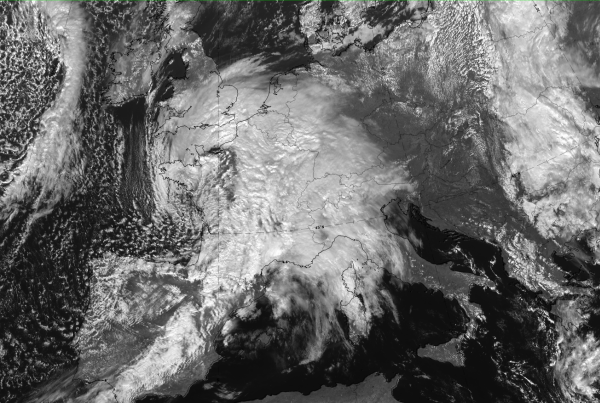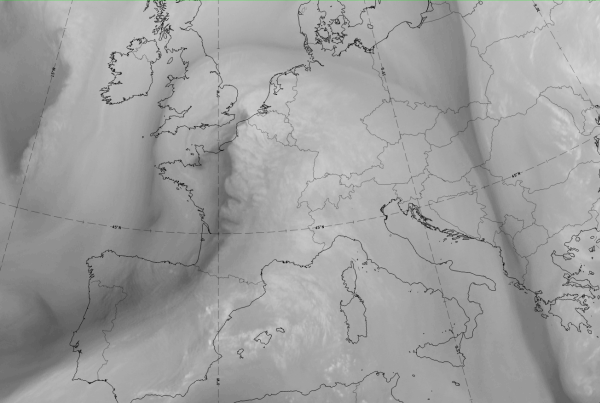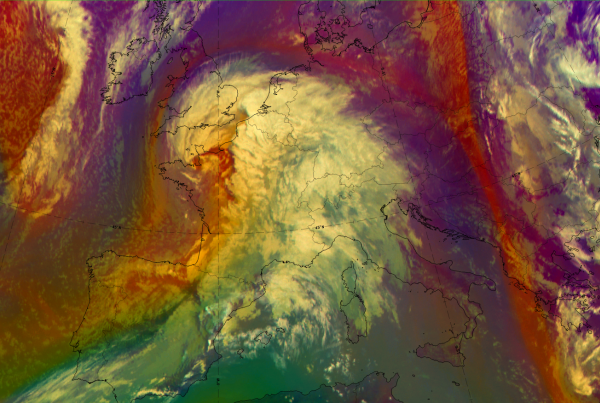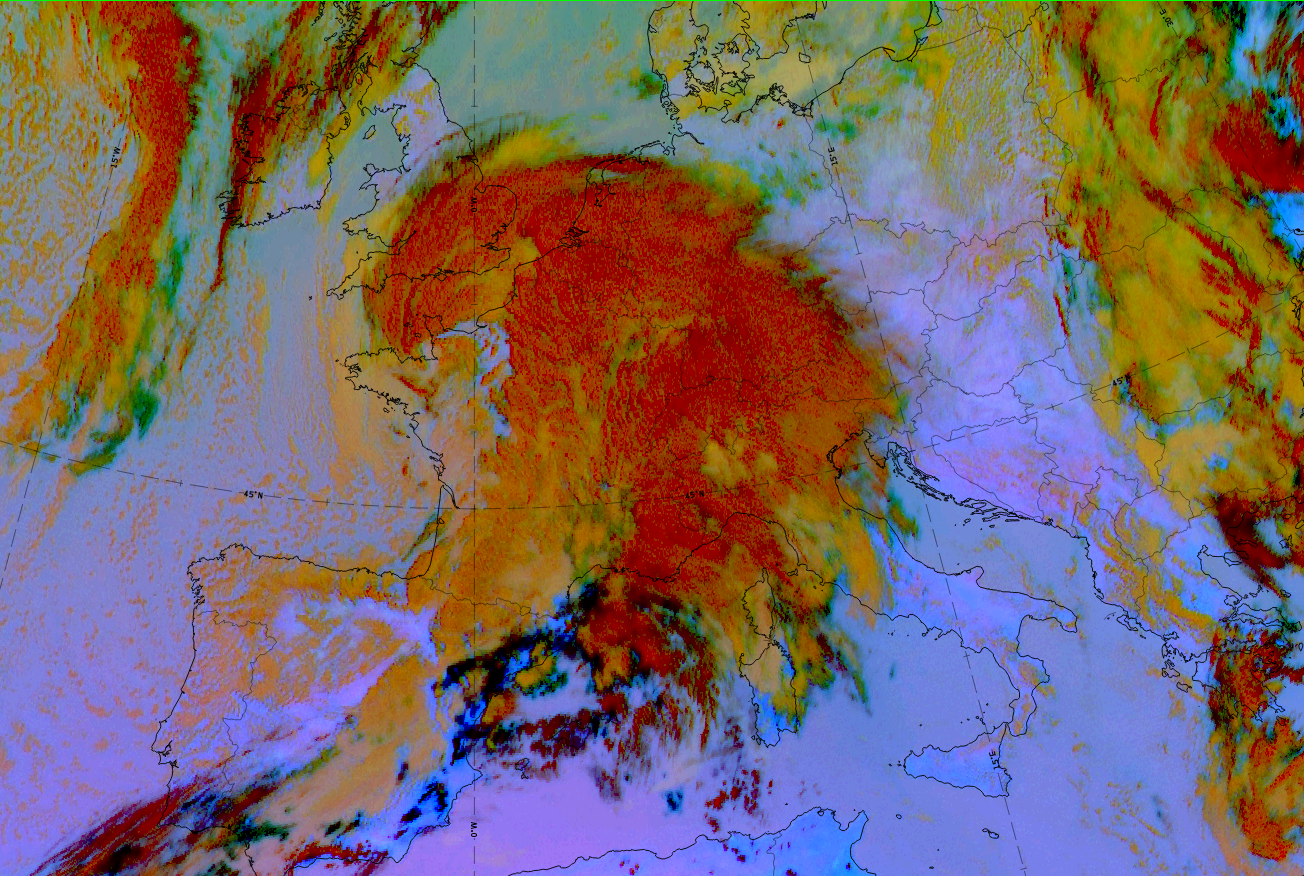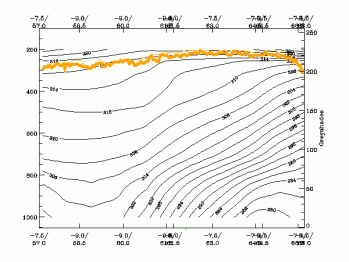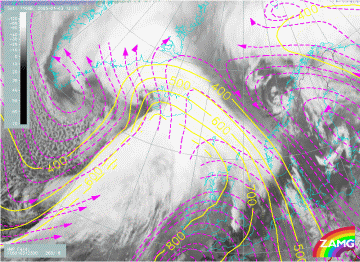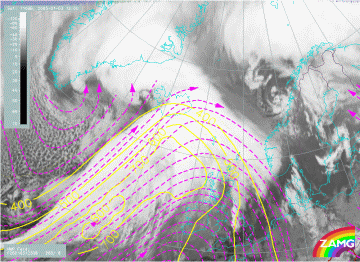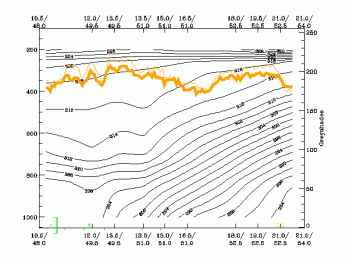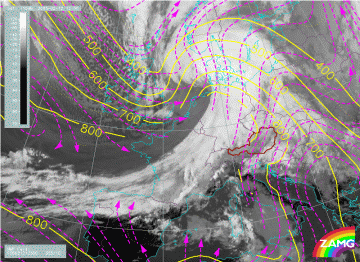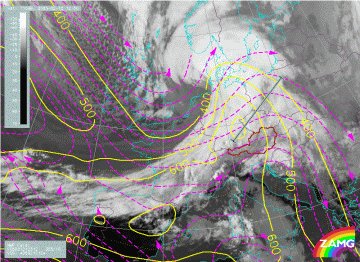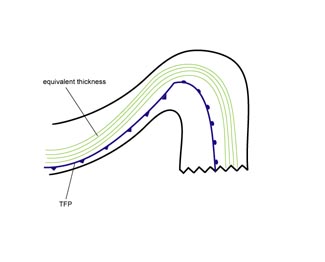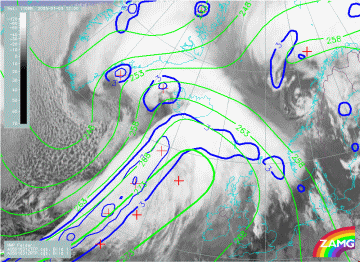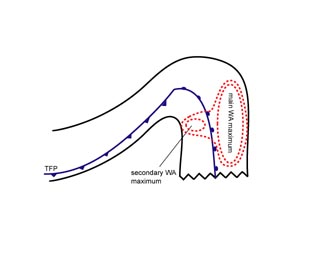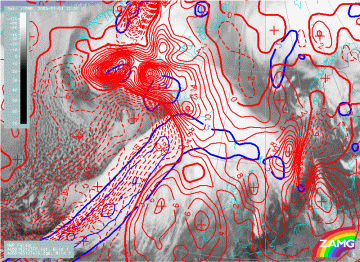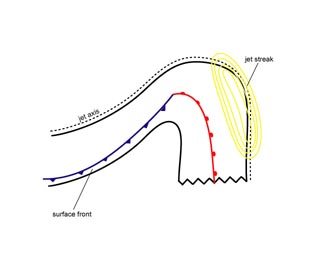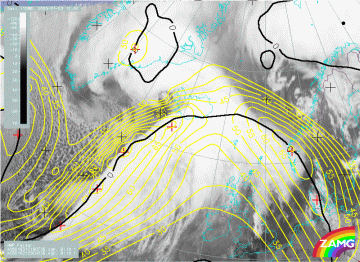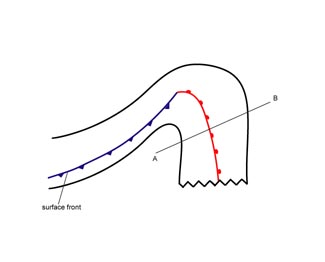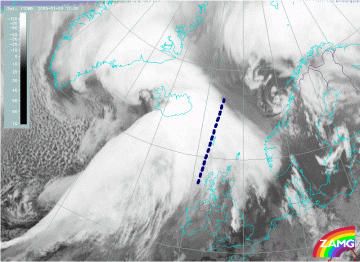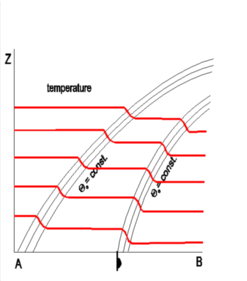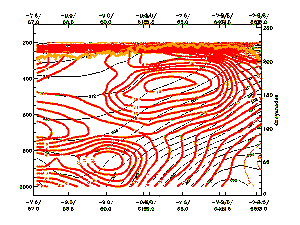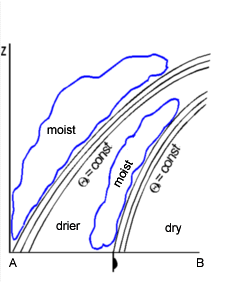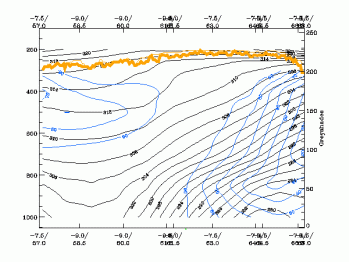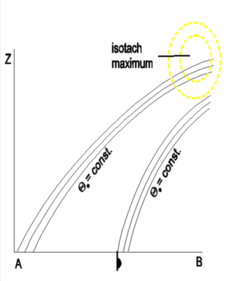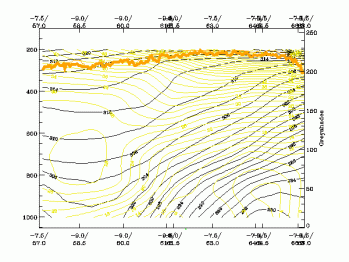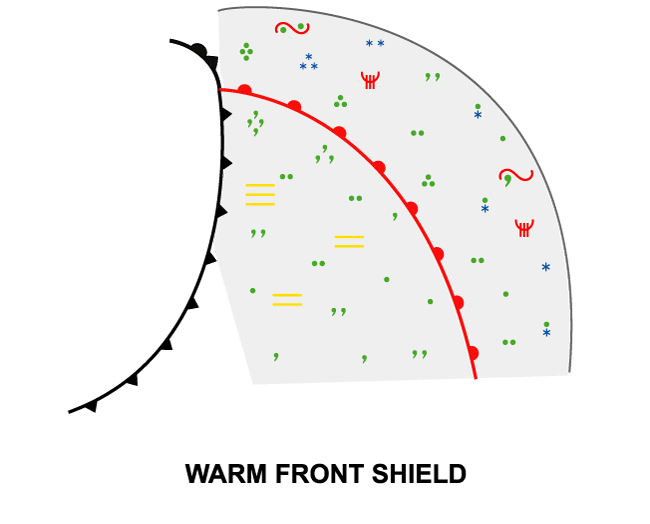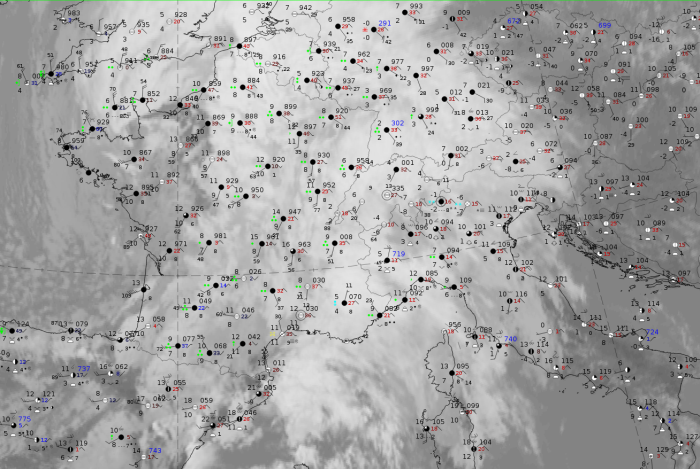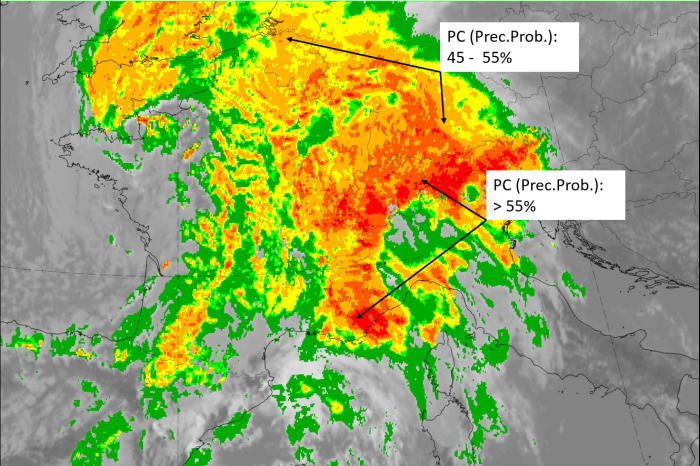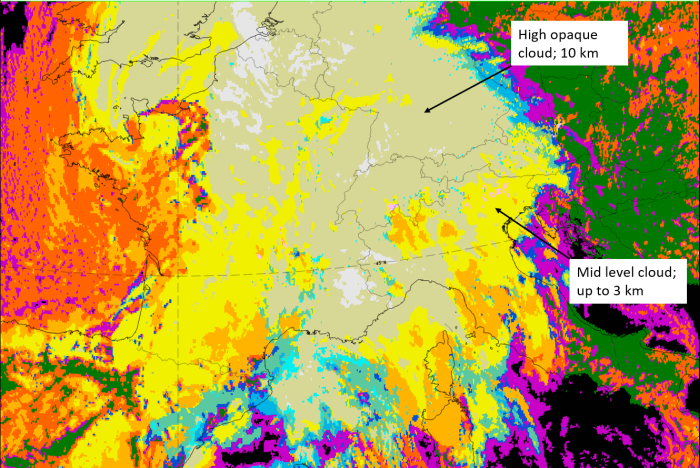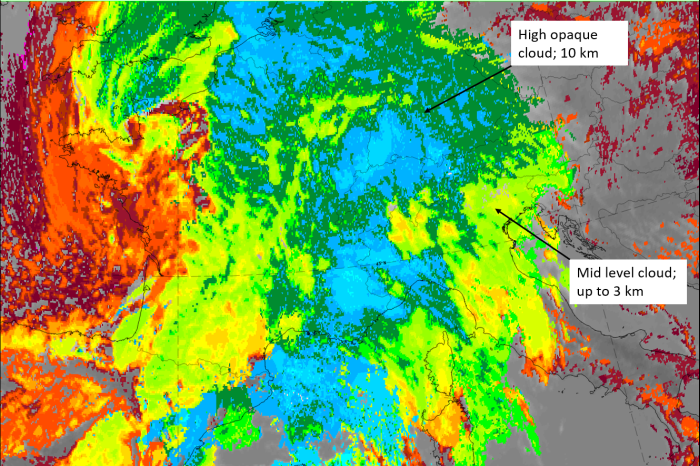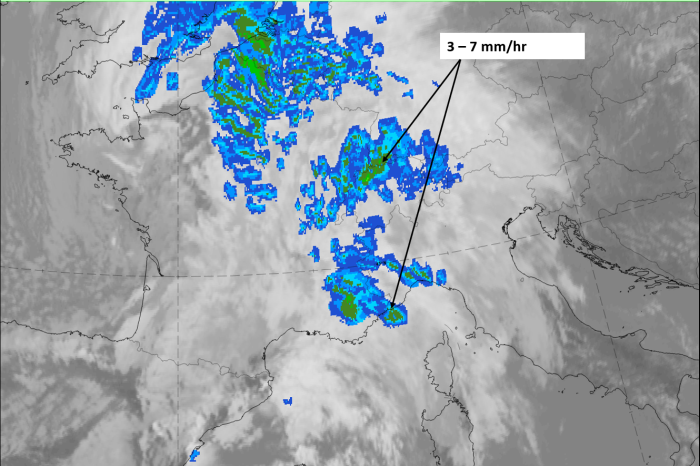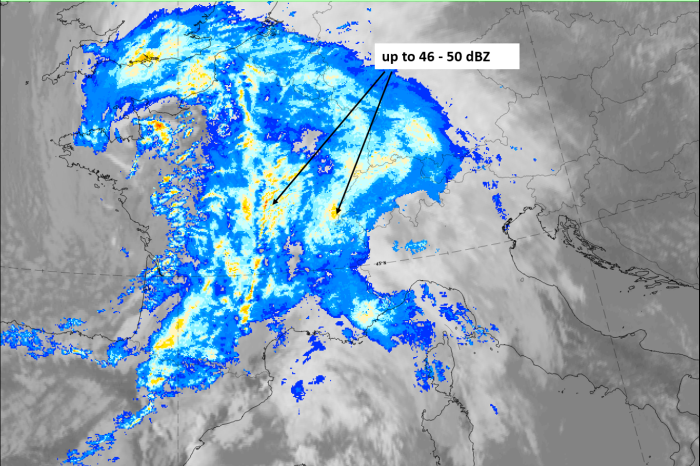Table of Contents
Cloud Structure In Satellite Images
In the satellite image a synoptic scale cloud shield which lies in front of a cold front represent a Warm Front Shield, which comprises the area of the warm front and the warm sector.
Appearance in the basic channels:
- In the VIS image the grey shades are generally white within the warm sector (in a well developed case) and near the surface warm front,while the grey shades become gradually more and more grey towards the forward cloud edge (see Warm Front Band).
- In the IR image the grey shades of the cloud shield are usually white, indicating cold cloud tops. However, very often they show substructures, which differ from case to case.
- The pixel values are high (bright) in the WV image within the area of the cloud shield.
- At the leading edge of the cloud shield the WV image shows that along the jet axis a sharp gradient from white to black exists, indicating dry air at the cyclonic jet side (see Warm Front Band).
In contrast to the warm front band (see Warm Front Band - Cloud structure in satellite image) the warm sector of the warm front shield is overcast with clouds within the ascending warm conveyor belt, which can (in a well developed case) extend through a substantially deep layer of the troposphere.
Appearance in the basic RGBs:
Airmass RGB
Usually, in front of the WF shield, dark blue colours indicate cold air masses. The warm front shield is part of the warm sector. to the S/SW of this cloud shield, the colours are usually greenish, representing warm air masses. Surrounding blue colours, partly even within the WF shield, belong to the colder airmass on which the warmer air is being uplifted. Another contributing factor is of high upper level humidity.
The clouds of the warm front shield are very similar to their appearance in the IR image.
Dust RGB
Blue to pinkish-blue colours can be seen where there is cloud-free region of land or sea. However, they are usually other cloud patches and configurations existing in front of the cloud shield. They are typically lower, especially in winter time when fog and stratus fields exist. These cloud configurations appear in different shades of ochre.
The colours of the warm front shield are dependent on the thickness of the cloud layer. Thicker areas appear dark red, indicating thick ice cloud. Lower cloud layers appear in yellow to ochre. Quite often the leading edge of the warm front cloud band is accompanied by a black fibres which strech along the jet axis there.
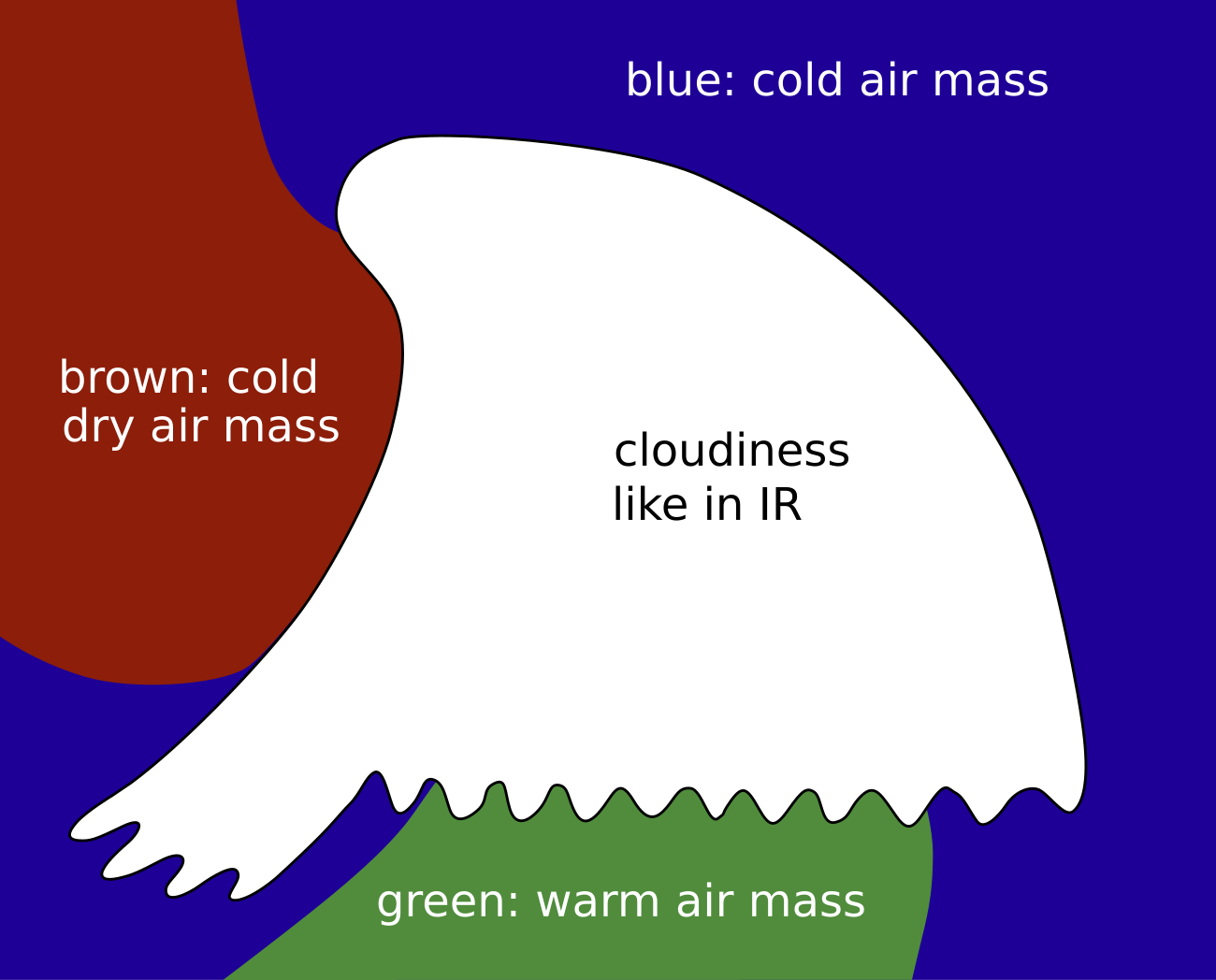 |
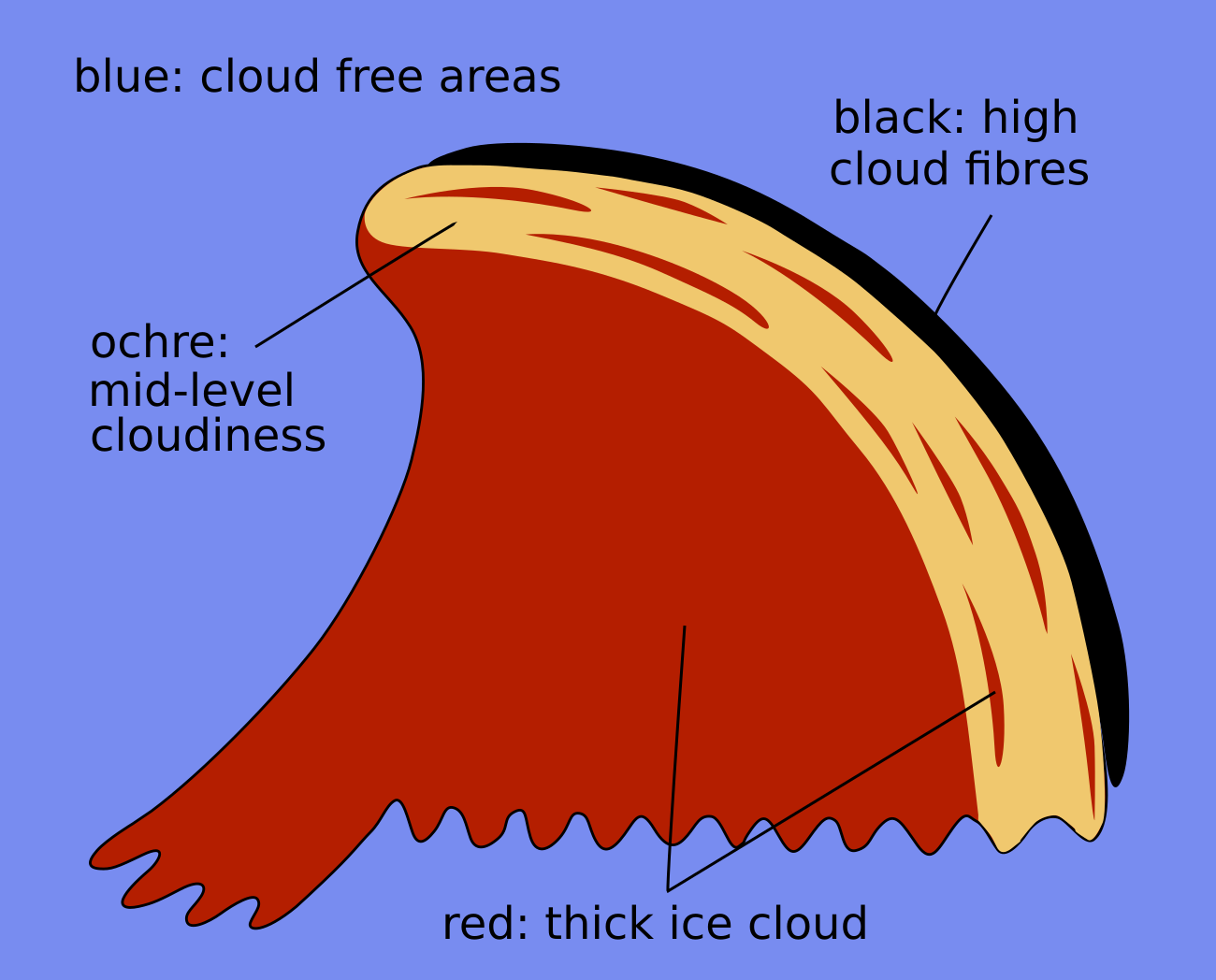 |
Legend: Schematics for basic RGBs; Left: airmass RGB; right: dust RGB.
The case of 5 March 2020 at 12 UTC shows a CF extending from Spain to Belgium. The cloud mass of a WF shield can be seen to the east over Germany, Switzerland, Austria, Italy and South-France. Many of the typical structures and grey shades mentioned above can be detected.
|
|
|
|
Legend:5 March 2020 at 12UTC: 1st row: IR (above) + HRV (below); 2nd row: WV (above) + Airmass RGB (below); 3rd row: Dust RGB + image gallery.
*Note: click on the Dust RGB image to access image gallery (navigate using arrows on keyboard).
| IR | Bright and structured. |
| HRV | Bright and structured with darker grey shades on the leading edge, over Germany. |
| WV | Light grey area of high humidity with some structures from embedded clouds; a dark stripe exists east of the WF shield cloud. |
| Airmass RGB | The dark-blue colours represent a cold airmass which exists to the east of the WF shield cloud. At the same time, cloud-free areas both within and to the south of the WF shield are indicated with greenish colours, signifying warm air masses. |
| Dust RGB | Ochre colours are commonly found in the southern and south-western parts of the WF shield and represent the mid-level cloud; dark-red colours indicate the thick ice cloud which is located more to the eastern and north-eastern parts. |
Meteorological Physical Background
The classical physical Warm Front model as well as the conveyor belt theory of Warm Fronts do not discriminate between the Warm Front Band and the Warm Front Shield. But the main difference between the Warm Front Band and the Warm Front Shield is the cloudiness within the warm sector (see Cloud structure in satellite image). It is not easy to understand this with the classical model. The conveyor belt theory better explains this feature.
The cloudiness within the warm sector is associated with a more or less pronounced upper level front (see Typical appearance in vertical cross section) and there is a pronounced ascending Warm Conveyor Belt on the various surfaces of these frontal zones. It overruns the Cold and Warm Front surface lines (which is different from the band type) and mostly exists in a deep layer of the troposphere. This may be the reason for thick cloudiness and precipitation in the warm sector behind the surface front.
Beside this upper level frontal zone there also exists a surface level frontal zone, which is comparable to the band type. Cloudiness on this frontal zone cannot normally be differentiated in the satellite image, but can be explained in a similar way as for the band type (see Warm Front Band - Meteorological physical background ). With this type a different relative stream from behind the Cold Front has already been described, forming the high Warm Front Band cloudiness. In the shield type this relative stream can only be seen in the area of the leading edge of the shield. Therefore this stream is either overrun or shifted forward by the dominant Warm Conveyor Belt.
In the case of the band type, it was stated that there is not enough ascending motion with the Warm Conveyor Belt, which is the reason that no cloudiness develops. In the shield type the ascent is much stronger: either this is the characteristic of the special situation or it is the consequence of a further development of the frontal system. If the frontal surfaces approach, then the isentropic surfaces become more and more inclined leading to a stronger ascent of the relative stream. This process can often be followed in the satellite images by the development of cloudiness in the warm sector of a Warm Front band culminating in the formation of the complete cloud shield (see Cloud structure in satellite images).
|
03 January 2005/12.00 UTC - Vertical cross section; black: isentropes (ThetaE), orange thin: IR pixel values, orange thick: WV pixel values
|
There is a distinct surface level and a developing upper level front. The 300K isentropic surface chosen for the relative streams in the first of two figures belongs to the pronounced surface frontal zone. The 308K isentropic surface in the second figure belongs to the upper level frontal zone.
|
3 January 2005/12.00 UTC - Meteosat 8 IR 10.8 image; blue: relative streams 300K - system velocity: 260° 8 m/s, yellow: isobars 300K
|
3 January 2005/12.00 UTC - Meteosat 8 IR 10.8 image; magenta: relative streams 308K - system velocity: 260° 8 m/s, yellow: isobars 308K
|
This isentropic surface is characteristic of the situation and cloud development at the surface frontal zone.
The most striking difference to the upper level surface is the northward shift of the ascending Warm Conveyor Belt
(left image). This causes an overrunning of the frontal line at a layer of about 700 to 500 hPa.
The second relative stream from behind the Cold Front cannot be observed on this isentropic surface.
This isentropic surface is characteristic of the situation at the upper level front as well as for the warm sector.
Although this situation is rather complex, representing the development and merging of several synoptic scale systems,
a lot of features described in the meteorological physical background above can be detected.
Both satellite images with superimposed relative streams show a pronounced ascending warm conveyor belt (ascent from
about 600 to 400 hPa). The increase of cloudiness within the warm sector is manifested in the relevant area from Iceland
to southern Norway.
|
12 February 2005/12.00 UTC - Vertical cross section; black: isentropes (ThetaE), orange thin: IR pixel values, orange thick: WV pixel values
|
The isentropic surfaces which are used for the relative streams are 300K, representing the situation within the lower levels of the troposphere, and 312K for the upper levels.
|
12 February 2005/12.00 UTC - Meteosat 8 IR 10.8 image; magenta: relative streams 300K - system velocity: 325° 10 m/s, yellow: isobars 300K, position of vertical cross section indicated
|
12 February 2005/12.00 UTC - Meteosat 8 IR 10.8 image; magenta: relative streams 312K - system velocity: 325° 10 m/s, yellow: isobars 298K
|
The upper left figure shows an ascending Cold Conveyor Belt from Switzerland/Austria across Germany and then further
north forming the cloudiness within the lower layers of the troposphere.
The second figure shows, within the Warm Front Shield, an ascending Warm Conveyor Belt originating in front of the Cold
Front south of the Alps (at approximately 650 hPa). Above Italy (at approximately 550 hPa) it turns from south-western
to south-eastern directions where it stops ascending above Croatia (approximately between 550 to 500 hPa).
Key Parameters
- Equivalent thickness:
The higher gradient zone of the equivalent thickness typical for a frontal zone can be found at the leading part of the cloud shield. - Thermal front parameter (TFP):
The TFP has its maximum close to the area of the surface front, which is situated within the cloud shield at the warm side of the higher gradient zone of the equivalent thickness. Consequently, no indication for the location of the surface Warm Front from the cloud image alone is possible. - Warm advection (WA):
The whole cloudiness of the Warm Front Shield (frontal cloudiness as well as the cloudiness of the warm sector) is within more or less strongly pronounced WA. Like the Warm Front described before (see Warm Front Band - Key parameters ), the field of WA increases towards the Occlusion point. Therefore its maximum can be found, in the case of an eastward moving frontal system, in the northern part of the cloud shield. A second, usually less pronounced, WA maximum can be found within the central part of the cloud shield (the warm sector). While the first maximum represents the Warm Conveyor Belt ascending to the surface frontal zone, the second maximum represents the Warm Conveyor Belt ascending to the upper level frontal zone (see Typical appearance in vertical cross section). - Shear vorticity at 300 hPa:
The zero line coincides with the leading edge of the Warm Front cloud shield. - Isotachs at 300 hPa:
The leading edge of the Warm Front cloud shield is superimposed upon a jet streak.
|
03 January 2005/12.00 UTC - Meteosat 8 IR 10.8 image; blue: thermal front parameter 500/850 hPa, green:
equivalent thickness 500/850 hPa
|
|
|
03 January 2005/12.00 UTC - Meteosat 8 IR 10.8 image; blue: thermal front parameter 500/850 hPa, red: temperature
advection 500/1000 hPa
|
|
|
03 January 2005/12.00 UTC - Meteosat 8 IR 10.8 image; yellow: isotachs 300 hPa, black: zero line of shear vorticity 300 hPa
|
|
Typical Appearance In Vertical Cross Sections
The isentropes of the equivalent potential temperature across the Warm Front Shield show two higher gradient zones: a surface Warm Front zone and an upper level Warm Front zone. Both zones are inclined from low to high levels and merge within the upper level of the troposphere. In both cases the colder air can be found in front of, and below, the warmer air behind and above the zones (see Meteorological physical background). The field of humidity shows high values immediately behind and within both frontal surfaces of the Warm Front. Lower values can be found below the higher gradient zones. Of special interest in this connection are the lower humidity values between the two frontal zones, indicating air masses of different origin.
Like the distribution of humidity, the field of temperature advection can also be separated into two parts. WA exists above and within the crowding zone of the surface warm front. CA can be found below and ahead of the surface front. In contrast, the upper level front is completely within WA, with higher values of WA above and within, and lower values below, the higher gradient zone. The maximum of the WA can be found within the higher gradient zones of both frontal surfaces. In the case of the surface warm front the WA maximum is situated at approximately 800 hPa while in the case of the upper level front it can be found at approximately 600 hPa. These two maxima correspond to the two WA maxima in the isobaric fields, the main one in front of and the second one behind the TFP (see Key parameters).
All three channels of satellite images across the Warm Front Shield show a broad area of high values. In the ideal case typical distributions can be observed. While the IR image shows, across the Warm Front Shield, only weakly increasing values of grey shades from the rear to the leading edge, the distribution of the grey shades in the VIS image is inverse (see Cloud structure in satellite image). The most pronounced feature in the WV image is the minimum associated with the dry air at the leading edge of the shield.
The sharp decrease of IR and WV pixel values at the leading edge of the Warm Front Shield is associated with a jet streak, which can be found at approximately 300 hPa.
|
03 January 2005/12.00 UTC - Meteosat 8 IR 10.8 image; position of vertical cross section indicated |
|
The first cross section shows temperature advection in red. The main maximum is connected with the surface Warm Front zone, the second weaker one can be found in the upper level frontal zone. According to the position of the surface front line, or the TFP, the main maximum is in front of it, the second one behind. The second figure shows relative humidity (blue). A zone of lower values discriminates the two zones of high humidity on top of the two frontal surfaces. The third and last figure shows a good coincidence between the jet maximum at 300 hPa and the sharp decrease of WV and IR pixel values, already mentioned before.
|
03 January 2005/12.00 UTC - Vertical cross section; black: isentropes (ThetaE), red thick: temperature advection - WA, red thin: temperature advection - CA, orange thin: IR pixel values, orange thick: WV pixel values
|
|
|
03 January 2005/12.00 UTC - Vertical cross section; black: isentropes (ThetaE), blue: relative humidity, orange thin: IR pixel values, orange thick: WV pixel values
|
|
|
03 January 2005/12.00 UTC - Vertical cross section; black: isentropes (ThetaE), yellow: isotachs, orange thin: IR pixel values, orange thick: WV pixel values
|
|
Weather Events
Warm Front Shields are associated with multi-layered cloud features, with abundant low and mid level clouds in the warm sector. Moderate to heavy precipitation can be found well ahead of the surface front, but after the passage of the front in the warm sector, slight to moderate precipitation is still possible.
| Parameter | Description |
| Precipitation |
|
| Temperature |
|
| Wind (incl. gusts) |
|
| Other relevant information |
|
For a demonstration of the typically associated weather events, the case of 5 March 2020 at 12 UTC is used as a representative sample.
|
|
Legend:
5 March 2020 at 12UTC: IR + synoptic measurements (above) + probability of moderate rain (Precipitting clouds PC - NWCSAF).
Note: for a larger SYNOP image click this link.
The biggest part of the WF shield over France and Western Germany shows wide-spread precipitation. To the east, over Eastern Germany and Austria there is no precipitation reported. In both the measurements and the precipitation probabilities from the NWCSAF, the enhancement of precipitation at the windward side of the Alps is obvious.
|
|
|
|
5 March 2020 at 12 UTC
1st row: Cloud Type (CT NWCSAF) (above) + Cloud Top Height (CTTH - NWCSAF) (below); 2nd row: Convective Rainfall Rate (CRR NWCSAF) (above) + Radar intensities from Opera radar system (below).
For identifying values for Cloud type (CT), Cloud type height (CTTH), precipitating clouds (PC), and Opera radar for any pixel in the images look into the legends. (link).
References
General Meteorology and Basics
- BROWNING K. A. (1985): Conceptual models of precipitation systems; Quart. J. R. Meteor. Soc., Vol. 114, p. 293 - 319
- BROWNING K. A. (1986): Conceptual models of precipitation systems; Weather&Forecasting, Vol. 1, p. 23 - 41
- CONWAY B. J., GERARD L., LABROUSSE J., LILJAS E., SENESI S., SUNDE J. and ZWATZ-MEISE V. (1996): COST78 Meteorology - Nowcasting, a survey of current knowledge, techniques and practice - Phase 1 report; Office for official publications of the European Communities
- GREEN J. S. A., LUDLAM F. H. and MCILVEEN J. F. R. (1966): Isentropic relative flow analysis and the parcel theory; Quart. J. R. Meteor. Soc., Vol. 92, p. 210 - 219
- HARROLD T. W. (1973): Mechanisms influencing the distribution of precipitation within baroclinic disturbances; Quart. J. R. Meteor. Soc., Vol. 99, p. 232 - 251
- HUBER-POCK F. and KRESS CH.(1989): An operational model of objective frontal analysis based on ECMWF products; Met. Atmos. Phys., Vol. 40, p. 170 - 180
- KURZ M. (1990): Synoptische Meteorologie - Leitfäden für die Ausbildung im Deutschen Wetterdienst; 2. Auflage, Selbstverlag des Deutschen Wetterdienstes
General Satellite Meteorology
- BADER M. J., FORBES G. S., GRANT J. R., LILLEY R. B. E. and WATERS A. J. (1995): Images in weather forecasting - A practical guide for interpreting satellite and radar imagery; Cambridge Universtity Press
- CARLSON T. N. (1987): Cloud configuration in relation to relative isentropic motion; in: Satellite and radar imagery interpretation, preprints for a workshop on satellite and radar imagery interpretation - Meteorological Office College, Shinfield Park, Reading, Berkshire, England, 20 - 24 July 1987, p. 43 - 61
- ZWATZ-MEISE V. (1987): Satellitenmeteorologie; Springer Verlag, Berlin - Heidelberg - New York - London - Paris - Tokyo
Specific Satellite Meteorology
- BENNETTS D. A., GRANT J. R. and MCCALLUM E. (1988): An introductory review of fronts. Part I: Theory and observations; Met. Mag., Vol. 117, p. 357 - 370
- BENNETTS D. A., GRANT J. R. and MCCALLUM E. (1989): An introductory review of fronts. Part II: A case study; Met. Mag., Vol. 118, p. 8 - 12
- CARLSON T. N. (1980): Airflow through mid-latitude cyclones and the comma cloud pattern; Mon. Wea. Rev., Vol. 108, p. 1498 - 1509
- HERZEGH P. H. and HOBBS P. V. (1980): The mesoscale and microscale structure and organization of clouds and precipitation in mid-latitude cyclones. Part II: Warm front clouds; J. Atmos. Sci., Vol. 37, p. 597 - 611
- HOSKINS B. J. and HECKLEY W. A. (1981): Cold and warm fronts in baroclinic waves; Quart. J. R. Meteor. Soc., Vol. 107, p. 79 - 90
- HOUZE R. A. JR., RUTLEDGE S. A. and HOBBS P. V. (1981): The mesoscale and microscale structure and organization of clouds and precipitation in mid-latitude cyclones. Part III: Air motions and precipitation growth in a warm frontal rain band; J. Atmos. Sci., Vol. 38, p. 639 - 649
- LOCATELLI J. D. and HOBBS P. V. (1987): The mesoscale and microscale structure and organization of clouds and precipitation in mid-latitude cyclones. Part XIII: Structure of a warm front; J. Atmos. Sci., Vol. 44, p. 2990 - 2309
- RUTLEDGE S. A. and HOBBS P. V. (1983): The mesoscale and microscale structure and organization of clouds and precipitation in midlatitude cyclones. Part VIII: A model for the "seeder - feeder" process in warm frontal rain bands; J. Atmos. Sci., Vol. 40, p. 1185 - 1206
- ZWATZ-MEISE V. (1990): Satellite synoptic of warm fronts; Proceedings of 8th Meteosat Scientific Users' meeting, Norrköping, Sweden, 28 - 31 August 1990, p. 151 - 160
